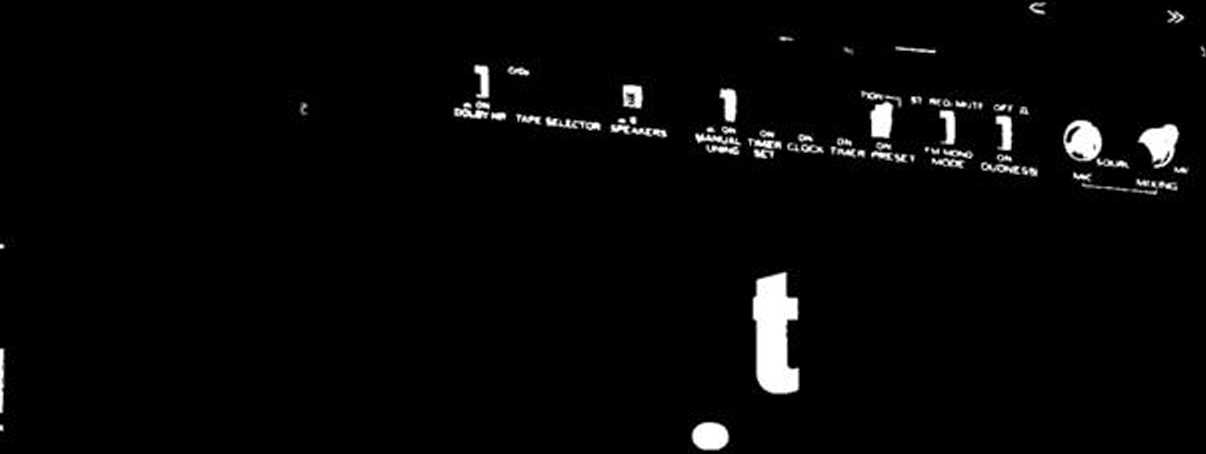5196106019
CLASSICAL Record Reviews
ł

The new Kenwood computerized AM/FM receiver and cassette deck.
We've married two of our most sophisticated audio components into one space-saving unit that makes beautiful musie a lot easier to make. And even easier to afford.
The KRX-7 Computerized Cassette Receiver.
With all its Computer controlled functions, the KRX-7 can do remarkable things with cassette tapes. Like automatically fast forward or rewind to any cut you tell it. Play the same cut over agam. Or even the same side. As many times as you want.
It even handles metal tape.
With its computerized receiver, the KRX-7 also has the intelligence to make AM/FM listening easier. It can automatically find the next station on the dial, and lock it in perfectly.
It's even smart enough to locate your 10 favorite stations at the push of a button.
For great performance without a greal deal of complica-tions, see the new KRX-7 computerized cassette receiver at your Kenwood dealer. And ask about its matching Kenwood turn-table, 3-way speakers and system rack. The easy way to put a stereo system together.
And keep it all in the same ..........
great sounding family.
^KENWOOD
For the Kenwood dealer nearest you. write Kenwood. P.O. Box 6213.
Carson. CA 90749.
F.rard in London. 1X02). Moreover. the Amsterdam Mozart Ensemble players. twenty-three strong. also use period or replica instruments—all individually identified in the notes-in these 1972 Seon recordings previously available from ABC and MCA.
I hstened to the earlier release of these performances—the lirst (and ap-parently still the only one) on period in-struments—with considerable dubiety about their worth beyond the merely
J *
historical. The great Dutch recorder and Butę virtuoso. Frans Briiggen. seemed to conduct with less than his usual as-surance: some of the slow solo and ensemble passages seemed labored: and the pressings were noisy. the isolated Andante and Rondo mislabeled.
These last faults have been cor-rected. although there is still some back-eround noise. undoubtedK built-in. And
Sm. .•
to present-day ears. the period instru-ments themselves sound rough. evcn harsh. in fortissimo tuttis. Nevertheless.
mv own musical education has been eon-
*
tinuingand my appreciation of “authen-tic” styles has widened. Now I find the tonal qualities—astonishingly different from and far morę piquant than the blander timbres of modern instru-ments—cndlessly rewarding and fasci-nating. I still hesitate to recommend this kind of Mozart to nonspecialist listeners. but l*ve come to delight in it—as have. Lm surę. many other purists.
If. like Berlioz. you still consider the tiule the “demure high-school miss" of the orchestra, or if you still nourish the delusion that Mozart really was powr-erless w hen he was obliged to write for it. here is provocative evidence to the con-trarv! r.d.d.
REIMANN: Lear-See page 90.
SCHUBERT: Svmphonv No. 9, in C. D. 944.
Boston Symphony Orchestra. Colin l)avis. cond. Philips 9500 890. S 10.98. Tape: 7300 890. S 10.98 (cassette).
Colin Davis seems bent on transforming Schuberfs much-touted “heavenlv” lengths into ungodly ones: In company with James Loughran. in an obscure British version by the Halle Orchestra that I have not heard. he observes everv repeat—even that of the finale’s exposi-tion section. which is heralded by an in-terestingly bumptious first ending.
I know all about that “faithfulness to the score" bit: “If a composer indi-catesa repeat. he must have wanted it to be heard." But our pace of life has changed: surely Schubert (like Beetho-ven. et al.) would concede that we. the generał public. have now gained suf-(Continued on page 84)
Clrcla 4 on Raadar-Sanrlca Card

HIGH I IOKUTY
Wyszukiwarka
Podobne podstrony:
CLASSICAL Record Reviews Most of these “smaller" roles. I am sorry to say. are not well taken i
CLASSICAL Record Reviews orchestration in many placcs. Whilc nor-mally I deplore such practices. I f
CLASSICAL Record Reviews SONY PS-X600 ... $261 TECHNICS SL-0202 $104 TECHNICS SL-0L-1 $224
CLASSICAL Record Reviews TDK SUPER AYILYN NOW MAKES OPEN REEL GO TWICE AS FAR. Remarkable Super Avil
CLASSICAL Record Reviews ihe voiccs como through. and a complcie libretto is included. Choregos, a G
CLASSICAL Record Reviews I under his name. were the talk of Europę. After the affair with Princess
»»A TOTALLY DIFFERENT APPFOACH TO THE PROBLEMS OF RECORD WEAR CLASSICAL Record Reviews After two yea
CLASS1CAL Record Reviews (Continued from page 80) ficient familiarity with his musie that we do
Adwertisement I I TANDBERG TR 3030 AM/FM RECEIVER Tandberg engmeers have been able to in-corporate n
• iA D C Clrclo 47 on Rud«r*S«rvict Card SANSUI SONY CASSETTE DECK AM/FM RECEIVERLLe D-95M
Step 3. Smart Training Records ► Review this list for employees who are still curr
37vbu03 Vt, saver - Microsoft Visual Basic [design] My Computer Am& T NetWork
37vbu08 Vt, saver - Microsoft Visual Basic [design] My Computer Am& T NetWork
Our Xmas present: Up to $150 worth ot free imported classical recordings. Our failhful cuslomers nev
820D-2 I k\ AM Trai»xmiUcr The entirely new 820D-2 1-kW AM Transmitter offers many new and innovativ
09vbu02 My Computer Am Vt, mci - Microsoft Visual Basic [design] File Edit View insert Run Jools Add
09vbu08 LongDiss - Microsoft Visual Basic [design] My Computer Am& T NetWork
New Forms Taschen 034 computer-oriented than Eisenman and some others, Erie Owen Moss has nonethe-le
więcej podobnych podstron